How Big Do Black Water Moccosans Get in the Southeast
Contrary to popular belief, water moccasins and cottonmouth snakes are not different types of snakes.
It's often thought that water moccasins are harmless, non-venomous creatures, and cottonmouths are more dangerous and venomous. In reality, both terms refer to the same species, Agkistrodon piscivorus, which is the only venomous water snake in North America. Read on to find out more about cottonmouth snakes, also known as water moccasins, including how to identify them and where they are located.
Characteristics of Water Moccasins and Cottonmouths
Agkistrodon piscivorus, commonly referred to as the cottonmouth snake and the water moccasin, is a species of pit viper native to the southeastern United States. The only venomous water snake in North America – and the only semi-aquatic pit viper species – the water moccasin attains an average size of about 31.5 inches long, including the tail. Some subspecies and specimens are known to grow upwards of 71 inches long, however, and some can weigh as much as 10 pounds.

Members of the family Viperidae, cottonmouths are pit vipers. Like other members of this family, including rattlesnakes and copperhead snakes, water moccasins have heat-sensing facial pits between the eyes and nostrils. These pits are very sensitive and can detect even the tiniest differences in temperature, allowing pit vipers like the water moccasin to strike more accurately at prey. Indeed, the "pit" in "pit viper" directly references these specialized facial features, which is also an excellent way to distinguish these venomous snakes from their more harmless counterparts.
Thanks to their large venom glands, cottonmouth snakes have large jowls along their thick, muscular bodies, which average between 2 to 4 feet in length. Their large, triangular heads are a distinctive feature, and they are made even more prominent by the snake's narrower neck. The thin neck is another distinct feature because many snake species have no distinctive neck at all. Water moccasins have vertical, "cat-eye" pupils, and dark stripes extend out near each nostril. The snout is pale in comparison with the rest of the head.
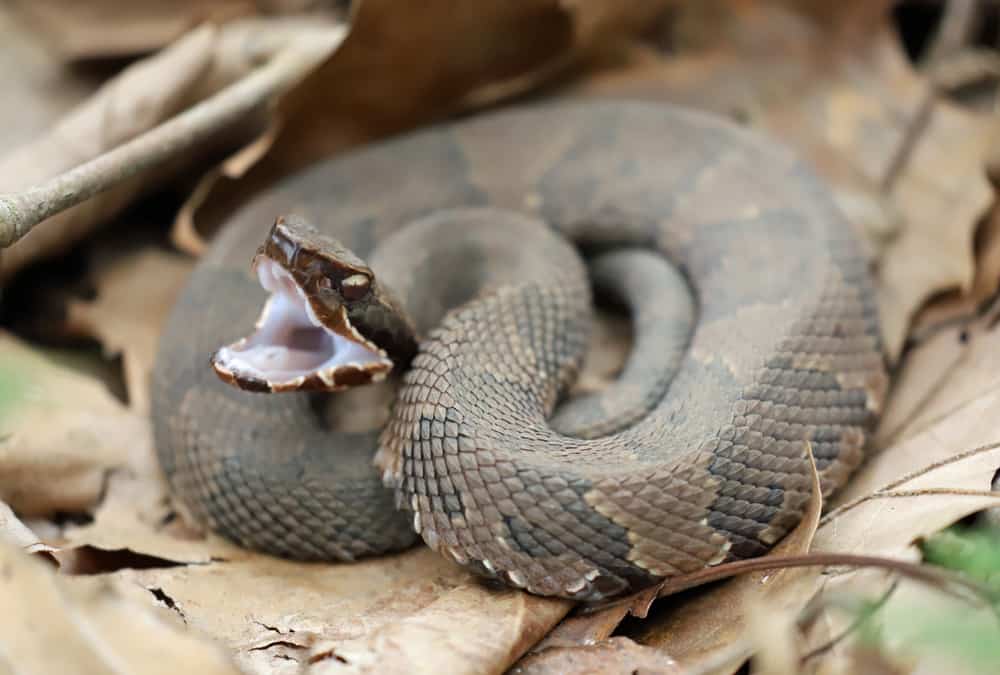
Another feature that the water moccasin is known for also lends it its other common name – cottonmouth. That's because the inside of the snake's mouth is bright white like cotton. When this snake feels threatened, it pulls itself into a distinctive S-like shape, rearing up and opening its mouth widely. The bright, white interior of the mouth stands in stark contrast to the rest of the snake, serving as a distraction as well as a warning sign. Indeed, it could be said that the water moccasin "waves a white flag" when feeling threatened.
The snake's body is thick and muscular but not exceptionally long, so it is relatively stout in appearance. Its body is covered by scales with distinctive keels, or ridges, along them. It may vary in color from black or dark brown to olive or even yellow. Some specimens have banded brown colorations. Cottonmouth snakes' bellies are paler than their backs.
Juvenile and young adult water moccasins tend to be lighter brown in color, and distinctive bands extend across their bodies. As they age, these bands and other patterns fade or are lost entirely. Therefore, if you see a cottonmouth with distinctive patterning, it is probably reasonably young. Additionally, the tips of juvenile water moccasins' tails are bright yellow, and the snakes use them as lures by waving them slowly back and forth.
Distinguishing Water Moccasins and Cottonmouths from Non-Venomous Snakes
People often mistake harmless snakes for cottonmouths, causing many non-venomous snakes to be needlessly killed every year. The northern water snake, Nerodia sipedon, is a common victim of this phenomenon. Although it looks a lot like a cottonmouth, the crossbands along its back don't widen at the ends like the northern water snake's.
If you live in a place where water moccasins are found, it helps to know how to distinguish them from non-venomous snakes. Some ways to tell them apart include:
- Swimming Style – Unlike the brown water snake, Nerodia taxispilota – another snake that's commonly mistaken for a water moccasin – the cottonmouth snake's whole body stays at the top of the water while swimming. Other water snakes, including the brown water snake, keep most of their bodies below the water while in motion, and only their heads show when not moving.
- Pupils – Non-venomous water snakes have round pupils. Water moccasins and other venomous water snakes, on the other hand, have vertical pupils that look similar to a cat's.
- Head Shape – Cottonmouth snakes have triangular heads while non-venomous snakes' heads are more slender and elliptical. A word of caution: When threatened, non-poisonous water snakes flatten their heads, making them look more triangular.
- Facial Pits – Pit vipers like the water moccasin have facial pits between their eyes and nostrils. Non-venomous water snakes lack these pits, so this is an easy way to tell them apart.
- Scales – Finally, water moccasins have a single row of scales after the anal plate while non-venomous water snakes have a double row.
Habitat
Water moccasins, or cottonmouths, are found across much of the southeastern United States. Their range extends from southern Virginia across Florida to eastern Texas. These pit vipers preferred habitats include marshes, swamps, and drainage ditches. They are also commonly found on the edges of streams, lakes, and ponds. They tend to be especially prevalent in areas where wading birds gather to breed.
When on land, cottonmouth snakes stay close to the water, and they are often found in open fields. Because they are cold-blooded like all snakes, this species spends a lot of time basking in the sun along the water's edge on logs, branches, and stones.
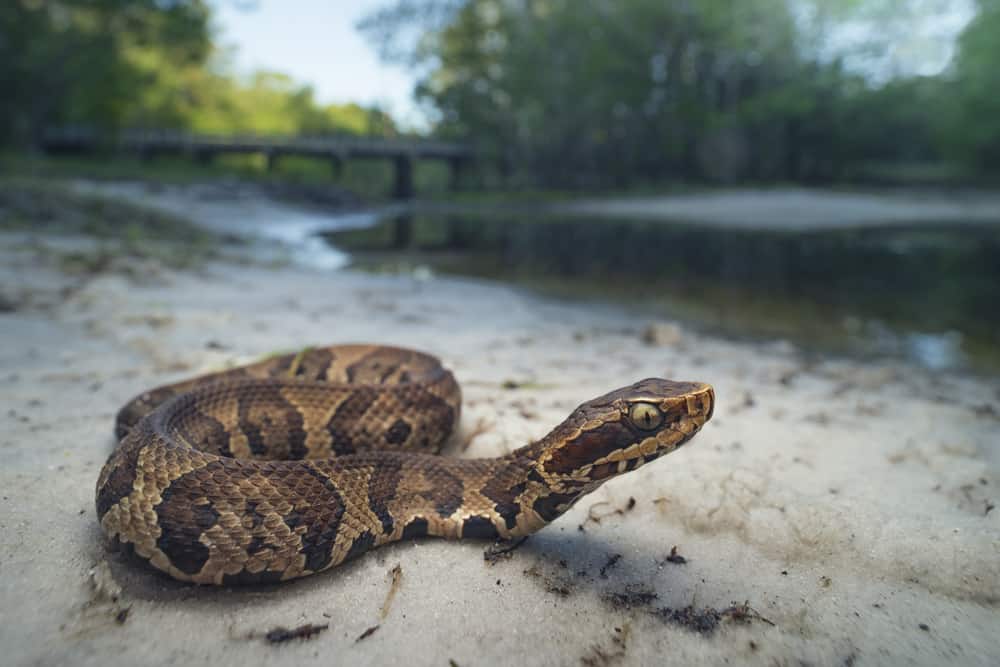
Habits of Cottonmouths and Water Moccasins
Cottonmouth snakes are often believed to be highly aggressive, but they rarely attack humans. However, at the same time, these snakes will stand their ground when feeling threatened, and they aren't known to flee at the first sign of trouble. The water moccasin's most distinctive defensive feature is opening its mouth wide to display the bright, white interior of its mouth. This flash of white is a warning signal of sorts, alerting prey that the snake will not back down, which gives it a chance to run away. The cottonmouth snake is the only snake species to exhibit this behavior. Other defensive moves include flattening the body, which helps it to hide and evade detection and emitting a strong, pungent anal secretion that warns away would-be predators. In this way, these snakes are a bit like skunks.
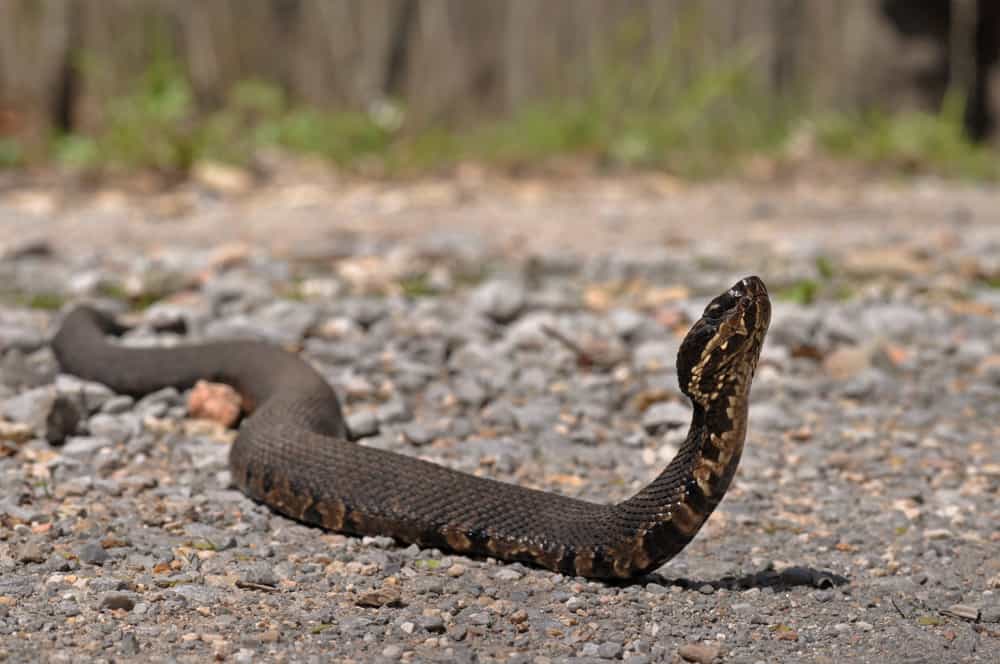
These water snakes keep their bodies along the surface while swimming, but they keep their heads sticking out. This can be an excellent way to identify them because many non-poisonous water snakes keep their bodies mostly submerged while swimming. They are active throughout the year in most areas, but they may become inactive at the onset of extremely cold weather. Under such circumstances, cottonmouths will hibernate until the weather warms up again, seeking out logs and holes in the ground for protection. They can be active by day and night, but they tend to hunt after dark. That's especially true during the summer months.
In terms of diet, water moccasins are large, muscular ambush predators, so they can prey upon a variety of different creatures. These carnivores' diets primarily consist of fish and frogs. However, they also consume other snakes, turtles, squirrels, rabbits, mice, rats, land snails, birds and their eggs, lizards, and even baby alligators. They may occasionally consume caterpillars, cicadas, and other insects too. Cottonmouth snakes may also eat smaller cottonmouths, so they are not opposed to cannibalism.
Water moccasins generally mate in the spring. Both sexes reach sexual maturity at around 2 to 3 years of age. When looking to mate, males slither around near females, waving their tails to lure them away from competitors. Male cottonmouth snakes often fight each other for the attention of female snakes, so displays of aggression are not uncommon during the mating season.
The cottonmouth snake is ovoviviparous, which means that it incubates its eggs inside of its body. Every two to three years, females give birth to live young after a gestation period of between three to four months. The average litter size includes 10 to 20 baby snakes, which are born with bright, distinctive colors. Water moccasins provide no parental care, so newborn snakes slither off to start life on their own immediately.
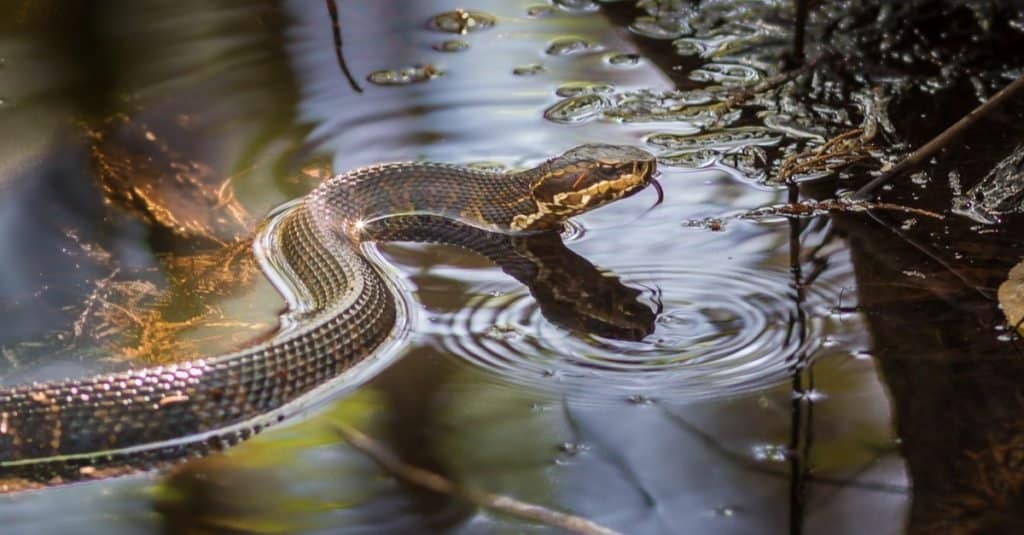
Classification and Taxonomy
Agkistrodon piscivorus, also known as the water moccasin or cottonmouth snake, belongs to the class Reptilia, the order Squamata, the family Viperidae and the genus Agkistrodon. It is one of eight species of pit vipers belonging to that genus.
In terms of etymology, Agkistrodon is derived from the Greek word ancistro, meaning "hooked," and odon, meaning "tooth." The term piscivorus is derived from the Latin word piscis, meaning "fish," and voro, meaning "to eat." Therefore, the cottonmouth's scientific name can be translated to roughly mean "hooked-tooth fish eater." Of course, this snake has retractable teeth, but the overall shape of the jaw and teeth is fairly hooked. Since water moccasins are water snakes, their diets include a lot of fish. Therefore, it makes sense to refer to these snakes as fish eaters. However, their diets are more varied than that and include frogs, rodents and even small alligators.
In addition to water moccasin and cottonmouth, common names for this species include gaper, mangrove rattler, black moccasin, swamp lion, snap jaw, trap jaw, water mamba, water pilot and stub-tail snake. Different names may be used in different parts of the country. The nickname "gaper" refers to the way in which the snake opens its mouth when threatened. It stretches it open as widely as possible, producing a gaping effect that reveals the white interior. "Mangrove rattler" makes sense in that these snakes often inhabit mangroves; however, they are not rattlesnakes. Although they shake their tails like rattlesnakes, they don't have rattles; therefore, no noise is produced.

There are three water moccasin subspecies:
- Florida Cottonmouth – Known by the scientific name Agkistrodon piscivorus conanti, the Florida cottonmouth is named after famed herpetologist Roger Conant. This subspecies, also known as the green-tailed moccasin, is found in extreme southern Georgia and throughout Florida, including the Everglades.
- Western Cottonmouth – This subspecies, A. p. leucostoma, is the smallest of the bunch, with an average length of 27.5 inches. It is typically dark gray or brown in color and has little to no markings. Its range extends from southern Alabama across the Gulf Coast and continues into southeast and central Texas, Oklahoma, Missouri, Illinois, Indiana, southeastern Nebraska and western Kentucky.
- Eastern Cottonmouth – Found mostly in southeast Virginia, A. p. piscivorus, the eastern cottonmouth, averages between 20 and 48 inches in length. It is also found along the Atlantic coastal plain, across the lower Piedmont of the Carolinas and west across Georgia. This subspecies is found along riverbanks, peninsulas and even on coastal islands.
Behavior
Cottonmouth snakes are thought to be very aggressive, but that is an unfair stereotype. In reality, these snakes hardly ever bite or attack humans. If they notice humans in the area, they generally slip away quietly to avoid confrontation. When confronted by predators, however, they are more likely to stand their ground than to flee. The water moccasin will pull itself up into a dramatic S-shaped configuration when threatened. It opens its mouth very widely, exposing the bright white interior of its mouth. The white color is reminiscent of cotton, which is why the snake is called the cottonmouth in many parts of the country. Ironically, its range is primarily the southern US, where cotton was once king. More than likely, the term "cottonmouth" had at least a little to do with the preponderance of cotton across this part of the country and the crop's cultural significance.
Male cottonmouths tend to become aggressive during mating season, and they often fight other males to get attention from females. As ambush predators, they prefer sneaking up on potential prey before striking. The element of surprise helps them to take on larger animals, including baby alligators. Water moccasins use the pits on their faces to detect even minute changes in heat. This allows them to hone in on the precise location of prey, making it easier to strike accurately. These poisonous snakes have retractable fangs, and they store venom in large glands that form jowls below their heads.
Bite
The cottonmouth snake is the only venomous water snake in North America. Although it rarely bites humans, this semiaquatic snake will attack quickly when threatened. It possesses a powerful cytotoxic venom that is stronger and more severe than that of the copperhead snake, so it is rightfully feared by people who live in areas where it is found. However, this snake's venom is not nearly as dangerous or toxic as the rattlesnake's.
When the cottonmouth strikes, it bites on and clamps down tightly. From there, they inject venom into their victim. This snake's potent venom is mostly made up of hemotoxins, which break down blood cells. Therefore, when this venom enters a victim's system, it prevents blood from clotting or coagulating like it normally does. As a result, if a water moccasin bites you, you may experience hemorrhaging within your body wherever the venom is spread by your circulatory system.
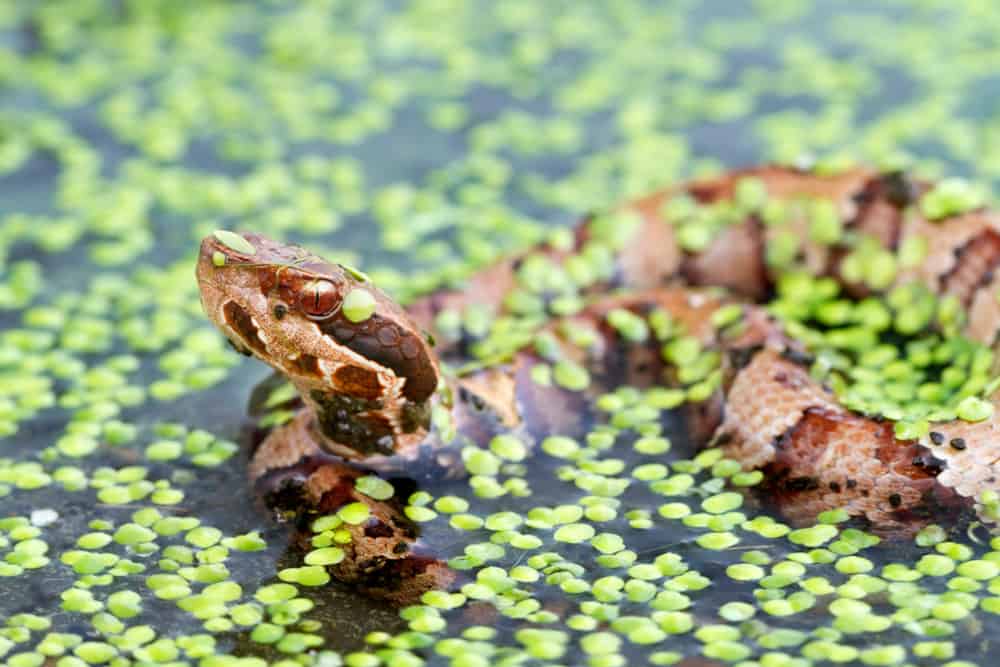
Being bitten by a cottonmouth is rarely fatal. However, it can cause severe damage, and it is considered a medical emergency. Water moccasin venom can cause temporary or permanent muscle damage. Sometimes, people lose an extremity because of the damage that is caused by the venom. For example, the tissue within a hand or foot may become so starved for oxygenation through the blood that it becomes seriously damaged. If the situation is not addressed quickly enough, amputation may be necessary.
Internal bleeding is another serious potential side effect of being bitten by a water moccasin. Since it's not usually readily apparent, it's essential to seek medical care even if everything seems okay. Victims of water moccasin bites also experience extreme pain around the area where they were bitten.
People residing in parts of the country where cottonmouths are common should also take care to protect their pets from these snakes. Dogs and cats may accidentally run across a cottonmouth in the wild and be attacked. Smaller animals are more likely to come to serious harm from the venom, and they can actually die from such snake bites.
Cottonmouth, Water Moccasin – One and the Same
With its many different nicknames, Agkistrodon piscivorus is often confused with other snakes. Although many people believe that water moccasins are distinct from cottonmouth snakes, the truth is that they are one and the same. Regardless of what it's called, all subspecies of this snake are venomous but not particularly aggressive. Before killing a snake that you think is a cottonmouth, try to confirm that it's not a different water snake species. Further, since cottonmouths prefer to flee rather than fight, it's often unnecessary to do anything other than stand aside and wait. By understanding the differences between cottonmouths and non-venomous water snakes, you can avoid causing unnecessary harm to these creatures, so be sure to study up before venturing out into areas where it may be encountered.
How Big Do Black Water Moccosans Get in the Southeast
Source: https://a-z-animals.com/blog/water-moccasins-vs-cottonmouth-snakes/